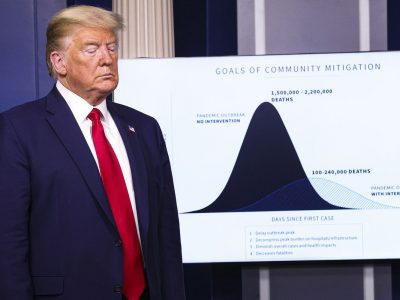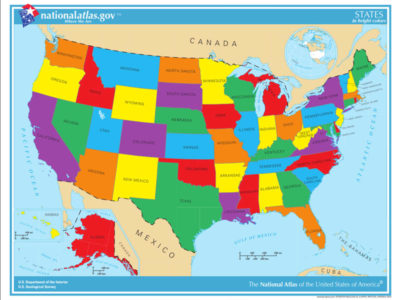Politics
Election 2020: The Battle for the Senate
Whatever happens to the White House, control of the Senate will be crucial.
Today, I’ll look at how key races have shifted in the past six month, and why this matters for environmental law. We’ve just finished the Democratic Convention, and the GOP Convention is underway. But control of the Senate may be equally important.It’s crucial to any president’s legislative agenda and judicial appointments. Senate control gives an …
Continue reading “Election 2020: The Battle for the Senate”
CONTINUE READINGTrump Finds His Medical Rasputin
The newest addition to Trump’s coronavirus task force is a faux expert who just happens to share all of Trump’s views.
President Trump has added a new member to his coronavirus task force, Dr. Scott Atlas. It’s no wonder that Trump loves Dr. Atlas, a retired Stanford radiologist who frequently appears on Fox. Atlas thinks “we are committing national suicide” if we continue serious health precautions against the coronavirus. Here are more of Dr. Atlas’s dubious …
Continue reading “Trump Finds His Medical Rasputin”
CONTINUE READINGThe Draft Democratic Platform and the Environment
The Democrats are promising bold climate action but not committing to details.
The Republicans have decided not to update their 2016 platform, but the Democrats now have a draft of their 2020 platform. The platform essentially calls for aggressively moving beyond Obama’s actions (and eliminating Trump’s). For those who are in a rush, I’ll start with the takeaways. Key Points Here are some of the most important aspects …
Continue reading “The Draft Democratic Platform and the Environment”
CONTINUE READINGWhat Will Harris’s Nomination Mean for the Environment?
She’s been outspoken on climate and EJ issues, but her core interests may be elsewhere.
Kamala Harris has taken some strong positions on climate change and environmental justice. Her nomination signals the extent to which the Democratic party now embraces those issues. However, to the extent one can judge from her public record, her highest priority interests have been elsewhere during her time in the Senate. While campaigning for the …
Continue reading “What Will Harris’s Nomination Mean for the Environment?”
CONTINUE READINGManaging a Pandemic, Enron-Style
The Administration’s management harkens back to a spectacular business collapse at the turn of the century.
Think of this as a parable. I’ll draw out some parallels at the end with the Trump Administration’s handling of the coronavirus, as detailed in a story in Sunday’s Washington Post. But first I’ll let you make some of the connections yourself. The Trump team’s triumph in 2016 was one of the great upsets in …
Continue reading “Managing a Pandemic, Enron-Style”
CONTINUE READINGBP’s Surprising Pivot
An oil giant decides to face the future instead of fighting it.
With all that’s going on, it’s easy to miss what would in normal times be major news. On Tuesday, BP announced it was beginning to turn away from the oil business. The most significant thing may be this: BP stock rose after the announcement. BP has already sold its petrochemical business. It also announced that …
Continue reading “BP’s Surprising Pivot”
CONTINUE READINGElection 2020: Three Months till Election Day
The environmental are high: Trump has axed one regulation every two weeks for four years.
Since taking office, Trump has waffled on some issues and shuffled personnel, but on one thing he has held firm: eradicating legal protection of the environment. His motto seems to be: No Regulation Left Standing. Something to keep in mind, as we head toward Election Day. That’s three months away, but some states begin early …
Continue reading “Election 2020: Three Months till Election Day”
CONTINUE READINGElection 2020: Update on the Senate
Senate control will matter a lot, regardless of who’s in the White House.
Control of the Senate will determine the environmental views of new judges and whether any environmental legislation can pass. In August, I’ll start looking at the environmental stakes in specific Senate races. Here’s why Senate control is so important and where things stand right now. Basically, the question is whether Mitch McConnell retains his grip …
Continue reading “Election 2020: Update on the Senate”
CONTINUE READINGPlanning a Green Recovery
Don’t let the opportunity for a green stimulus go to waste.
The economy crashed during the lockdown. Although a recovery has begun, government action will probably be needed to sustain it. We should seize this opportunity to make progress on sustainability. It’s hard to know the long-term economic impact of the pandemic. As Nobel-prize winning economist Robert Schiller has said, “Big events like a pandemic have …
Continue reading “Planning a Green Recovery”
CONTINUE READINGElection 2020: State Legislatures
The Outlook for State Climate Policy Might Improve
The key political races aren’t just about the White House or Congress. Control of state legislatures will also be important in shaping climate and energy policy — not to mention their ultimate effect on the composition of the U.S. House due to redistricting. One of my themes is the importance of state government to climate …
Continue reading “Election 2020: State Legislatures”
CONTINUE READING











